Learn the secrets to making fabulous easy raspberry blueberry jam, sometimes called “Queen’s Jam”. This is one of the most unique blueberry jam recipes because, surprise, raspberries are not the only other fruit in the recipe. If you are looking for a delicious homemade food gift, this raspberry and blueberry jam recipe is a great gift idea. It’s also a terrific way to use a supply of frozen berries you may have lingering in your freezer. As a grower of both raspberries and blueberries, I’ve been making this colorful, flavorful jam for years. Ready for one of the best blueberry and raspberry recipes? Read on!
Table of Contents
My Raspberry Blueberry Jam Backstory
I’ve written before about the abundance of raspberries and blueberries which get stored in our freezer. If you deal with the issue of berry-buildup, check out this post for some ways to put frozen berries to good use. I keep finding more delicious recipes to help me use up the berry supply. Imagine my excitement when I discovered a recipe for raspberry blueberry jam! Wait, I thought, I can use two types of berries in one jam recipe? Is that allowed? Definitely!
As I read through the recipe, I was disappointed to learn it called for liquid pectin instead of the boxed powdered kind I’m used to. Hmmmm…that was a problem. I could hardly ever locate liquid pectin in my local stores. Why not adapt it to fit my needs? So I experimented with powdered pectin, and the recipe below is the result. I love the color and the flavor. If this seems blueberry and raspberry jam seems like a good idea you could use, keep reading. This blueberry raspberry jam recipe is perfect for serving at a raspberry or blueberry-themed party, as well as a fabulous tea party scone topping.
Ingredients for the Best Raspberry Blueberry Jam
3 cups fresh or frozen raspberries
2 cups fresh or frozen blueberries
1 orange
6 1/2 cups granulated sugar
2 tablespoons lemon juice (freshly squeezed is best)
1 2-ounce box powdered fruit pectin
Directions for the Best Raspberry Blueberry Jam
Wash 7 half-pint canning jars. Keep hot until needed. Prepare 2-piece canning lids as manufacturer directs.
Measure out the sugar in a mixing bowl so it will be ready to add to the berries all at once when needed.
Mash the raspberries and blueberries in a large, non-aluminum pot and set aside. I like to use a masher shaped like this one, so the blueberries do not get caught between the masher slots.
Using a zester (my favorite is this one, by Microplane), zest one orange and add the zest to the berries in the pot.
Be careful not to zest the white pith underneath the outer rind. Peel the orange, discard the peel, and finely chop the orange pieces in a food processor. Use the pulse setting. I like to use my electric mini-chopper for this little job.
Measure 1/2 cup of the orange pulp and add it to the pot containing the mashed berries.
Add the powdered pectin and lemon juice to the pot, then bring to a boil, stirring frequently. Add the pre-measured sugar all at once and continue to heat the mixture. Bring it to a full rolling boil over high heat, stirring constantly. Boil hard for one minute.
Ladle the hot jam into one hot jar at a time. To make this easier, I rely on my trusty canning tool set, which I purchased years ago.
It saves me so much time and mess. I would have given up on jam-making long ago if it weren’t for this set of tools.
Leave 1/4-inch head space in each jar. Wipe jar rims with a clean, damp cloth. Attach lids.
Process in a boiling water canner for 10 minutes (15 minutes at 1,000 to 6,000 feet; 20 minutes above 6,000 feet).
Raspberry Blueberry Freezer Jam Recipe
If you would like to turn this canned raspberry blueberry jam into a freezer jam, just use freezer friendly containers. Make sure to leave about one-half inch of headspace at the top before putting on the lid. Label each container and place in the freezer to enjoy when you are ready.
Huckleberry Raspberry Jam Recipe
It‘s easy to adjust this blueberry raspberry jam recipe to make it a huckleberry raspberry jam recipe. Simply substitute the blueberries in the recipe with huckleberries and follow the same instructions. If you have huckleberries (a precious commodity), this is one way to stretch out your supply and still have tasty jam to enjoy.
Common Questions About Raspberry Blueberry Jam
Why is raspberry blueberry jam called queen’s jam?
“Queen’s Jam” is not a specific type of jam with a standardized recipe or ingredients. The term “Queen’s Jam” is often used to refer to a high-quality or luxurious jam, fit for a queen. It can be associated with premium ingredients, unique flavor combinations, or jams made with care and attention to detail. The name “Queen’s Jam” is most often associated with raspberry blueberry jam, but the queens jam recipe term can also be used when referring to other special, unique queen jam recipes.
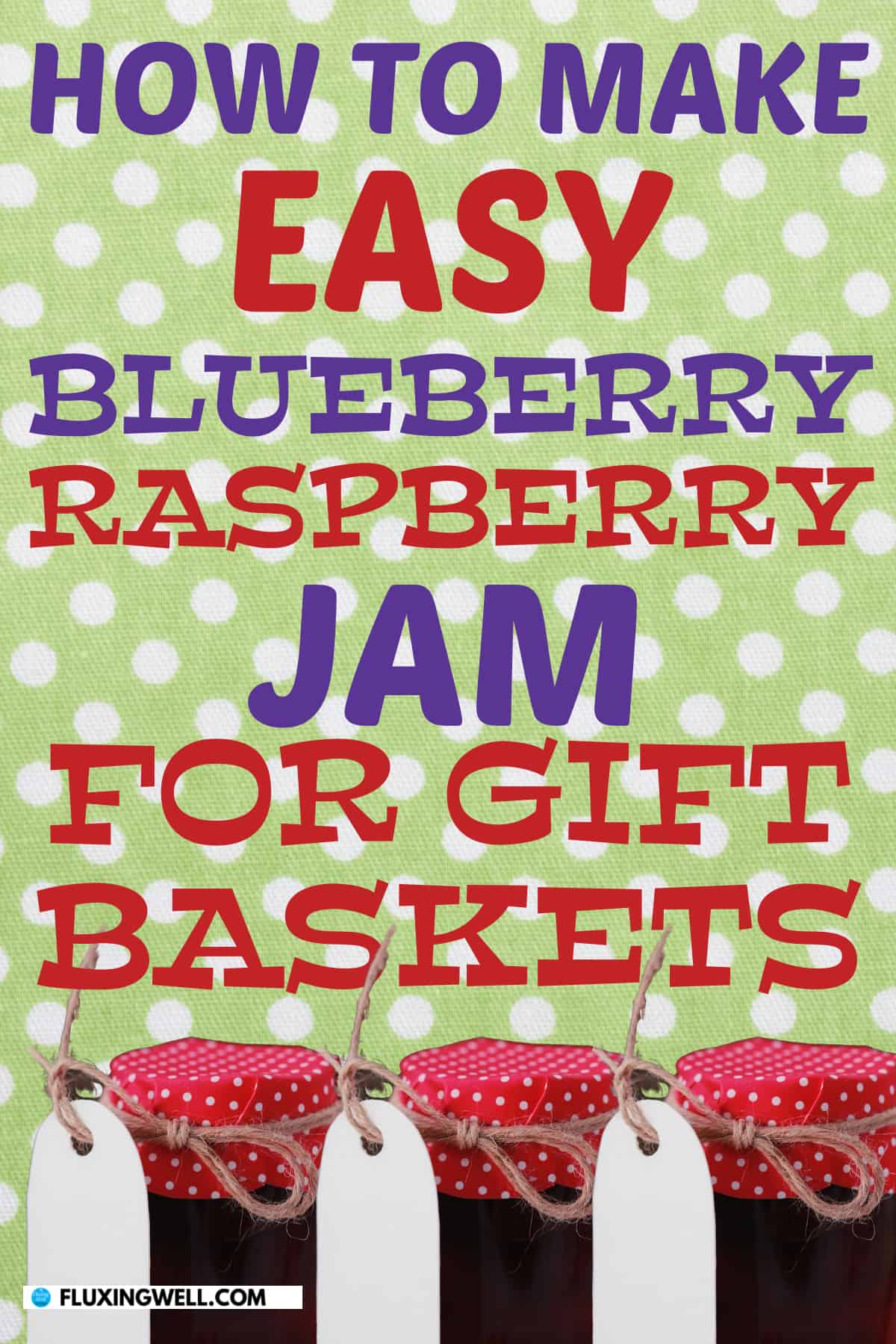
Should I wash blueberries before making jam?
It is generally recommended to wash blueberries before making jam. Washing the blueberries helps remove any dirt, debris, or potential pesticides that may be present on the surface of the berries. However, it is important to handle them gently while washing to avoid bruising or damaging the berries. I usually rinse mine gently in a colander.
Why is my raspberry blueberry jam grainy?
There are a few potential reasons why your blueberry jam may have a grainy texture:
Insufficient sugar: Sugar plays a crucial role in the queen‘s jam-making process as it helps the fruit release its natural pectin, which provides the jam’s desired gel-like texture. If there isn’t enough sugar, the pectin may not fully activate, resulting in a grainy texture.
Undercooking: If the blueberry jam is not cooked for a sufficient amount of time, the pectin may not fully develop, leading to a grainy consistency. It’s important to follow the recommended cooking times and temperature instructions in your jam recipe.
Improper mashing or pureeing: If the blueberries or raspberries are not properly mashed or pureed before cooking, it can result in a chunky texture with larger fruit pieces. Ensure that you sufficiently crush or puree the blueberries to achieve a smoother consistency.
Overripe raspberries or blueberries: Using overripe blueberries or raspberries can contribute to a grainy texture in the jam. Overripe fruit tends to have a higher water content and lower pectin levels, which can affect the final texture.
Insufficient stirring: While cooking the jam, it’s essential to stir it frequently to prevent scorching and ensure even heat distribution. Inadequate stirring can result in uneven cooking and a grainy texture.
By addressing these factors and adjusting your jam-making process accordingly, you can help achieve a smoother texture in your blueberry raspberry jam.

Can you overcook raspberry blueberry jam?
Yes, it is possible to overcook raspberry blueberry jam. Overcooking can result in a thicker, firmer, or even burnt jam with a less desirable texture and flavor. It’s important to follow the recommended cooking times and temperature guidelines in your raspberry blueberry jam recipe to achieve the desired consistency.
Overcooking can cause excessive evaporation of moisture from the jam, leading to a denser texture. It can also cause the natural sugars in the raspberries to caramelize or burn, resulting in a darker color and a potentially bitter taste.
To prevent overcooking raspberry blueberry jam, it’s recommended to closely monitor the cooking process, frequently stir the jam to ensure even heat distribution, and use a reliable candy thermometer to check the temperature. Follow the instructions in your recipe and aim for the recommended cooking time until the jam reaches the desired consistency.
If you accidentally overcook your raspberry blueberry jam, you can try adding a small amount of water or fruit juice to adjust the consistency and lessen the intensity of any burnt flavors. However, it’s best to avoid overcooking in the first place to maintain the best possible texture and taste.
Why is my raspberry blueberry jam bitter?
Using underripe raspberries or blueberries can contribute to a bitter taste in the jam. Raspberries and blueberries should be fully ripe before making jam to ensure optimal sweetness and flavor. If the berries were picked too early, they may lack the natural sugars needed to balance the tartness and may result in a bitter taste.
Overcooking raspberry blueberry jam can cause the natural pectin in the fruit to break down, resulting in a bitter taste. It’s important to follow the recommended cooking times and temperature instructions in your recipe to prevent excessive cooking. If the jam is cooked at too high of a temperature or for too long, the sugars in the raspberries and blueberries can caramelize and burn, resulting in a bitter taste. It’s important to monitor the cooking process closely and avoid excessive heat.
This raspberry blueberry jam recipe includes the addition of lemon juice or other acidic ingredients to help balance the sweetness and enhance the flavors. If too much citric acid is added or if the acidity levels are unbalanced, it can lead to a bitter taste. Ensure you are using the correct amount of lemon juice or other acidic ingredients as specified in this recipe.
To mitigate the bitterness in your raspberry blueberry jam, you can try adding a small amount of sugar or sweetener to balance the flavors. Additionally, adding a touch of vanilla extract or a pinch of salt may help counteract the bitterness. It’s always a good idea to taste and adjust the sweetness or acidity levels while cooking to achieve the desired flavor profile.
How do you thicken raspberry blueberry jam?
To thicken blueberry jam, you can use the natural pectin present in the fruit or employ additional thickening agents. In this recipe, the blueberries and raspberries contain natural pectin, which helps in thickening the jam. Ensure you’re using ripe blueberries and raspberries, as unripe ones have less pectin. Cook the blueberries and raspberries with sugar, the orange, and lemon juice (acidic ingredient) over medium heat until the fruit softens and releases its pectin. As the mixture cooks and reduces, the pectin will thicken the jam naturally.
This recipe also calls for pectin powder. This provides a quicker and more controlled thickening process. Follow the instructions provided with the pectin product and incorporate it into the jam mixture during cooking.
Some people use cornstarch or arrowroot. I have found from experience that these starch-based thickeners may slightly alter the texture and clarity of the jam.
Remember to follow a recipe or guidelines specific to the thickening method you choose to ensure proper ratios and instructions. It’s also crucial to cook the jam to the recommended temperature or until it reaches the desired consistency for proper preservation.

How long does homemade raspberry blueberry jam last?
Homemade raspberry blueberry jam can typically last for about 1 to 2 years when properly stored. The exact shelf life can vary depending on various factors, such as the ingredients used, the cooking and sealing process, and the storage conditions.
To ensure the longest possible shelf life for your homemade jam, follow these guidelines:
Properly seal the jars: Use sterilized jars and lids, and ensure a proper seal during the canning process. This helps create an airtight environment that prevents the entry of contaminants and extends the shelf life.
Store in a cool, dark place: After sealing, store the jars in a cool and dark location, such as a pantry or cellar. Avoid exposing the jam to direct sunlight or high temperatures, as this can accelerate spoilage.
Check for signs of spoilage: Before consuming the jam, always inspect the jars for signs of spoilage, such as mold growth, off odors, or bulging lids. If you notice any of these signs, discard the jam immediately.
It’s important to note that homemade jams may start to lose their quality, flavor, and texture over time. While they may still be safe to consume beyond the recommended shelf life, the taste and texture may deteriorate.
To make the most of your homemade raspberry blueberry jam, label the jars with the date of preparation and consume them within the first year for the best quality.
What is the best sugar for jam?
The best sugar for making jam is granulated white sugar. It is the most commonly used and readily available sugar for jam-making. Granulated white sugar dissolves easily, helps to preserve the color and flavor of the fruit, and provides the right level of sweetness.
There are other types of sugars that can be used for making jam, but they may have different effects on the final product:
Cane sugar: Cane sugar is similar to granulated white sugar and can be used interchangeably in jam-making. It is derived from sugar cane and has a slightly different flavor profile.
Light brown sugar: Light brown sugar contains a small amount of molasses, which can add a subtle caramel flavor to the jam. It can work well in certain fruit jams, providing a deeper taste.
Honey: Honey can be used as a natural sweetener in jam-making. However, it can alter the flavor and consistency of the jam, so it’s important to follow a recipe specifically designed for using honey.
When making jam, it’s generally recommended to use a recipe that specifies the type and amount of sugar to use. This ensures the right balance of sweetness, texture, and preservation. Experimenting with different sugars can result in variations in flavor, color, and set, so it’s important to consider the desired outcome and consult reliable recipes for the best results.
Should I stir jam while it’s boiling?
Yes, it is generally recommended to stir jam while it’s boiling. Stirring serves a few purposes during the jam-making process:
Prevent scorching: Stirring helps distribute the heat evenly and prevents the jam from sticking to the bottom of the pot or pan. This reduces the risk of scorching or burning the jam, which can negatively affect its flavor and texture.
Ensure even cooking: By stirring the jam, you help to ensure that all the fruit and sugar are exposed to the heat uniformly. This promotes even cooking and helps the fruit break down and release their natural pectin for proper thickening.
Control consistency: Stirring allows you to monitor the consistency of the jam as it boils. You can observe how the mixture thickens and adjust the cooking time accordingly to achieve the desired consistency. Stirring also helps to identify any clumps or unevenly distributed ingredients that need to be broken down.
While it’s important to stir the jam during the boiling process, it’s also crucial to be mindful of the heat level. Adjust the heat to a gentle boil and stir frequently to prevent sticking and scorching. Additionally, using a large pot or pan with ample room for the mixture will help minimize the risk of overflowing as it boils.
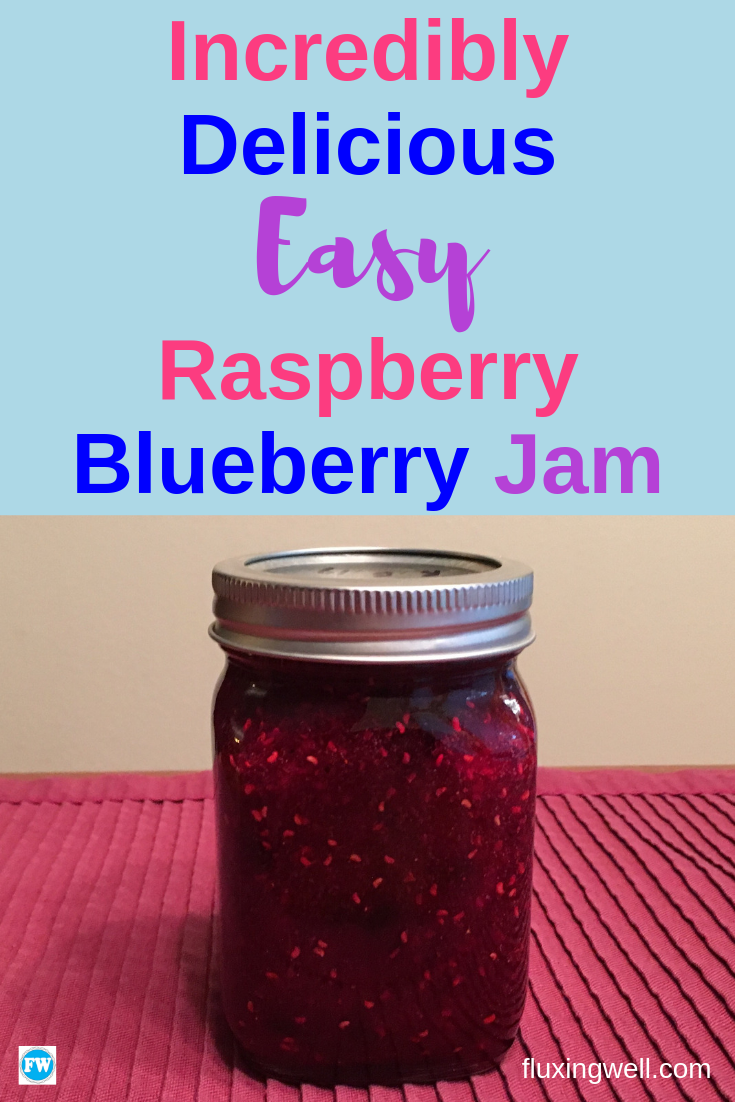
Do you cook jam with lid on or off?
When cooking jam, it is generally recommended to cook it with the lid off. Cooking the jam without the lid allows for evaporation of excess moisture, which helps the jam thicken and achieve the desired consistency.
Leaving the lid off the pot or pan allows the steam to escape, enabling the liquid in the jam to reduce and concentrate. This process is crucial for achieving the right texture and thickness of the jam.
Cooking the jam with the lid on can trap the steam and hinder the evaporation process, resulting in a runnier or more watery jam. However, there may be certain situations where a lid can be used temporarily, such as when bringing the mixture to a boil or when initially softening the fruit. Once the boiling point is reached, the lid should be removed to continue the cooking process without the lid.
Why do you add lemon juice to jam?
Lemon juice is commonly added to jam for a few important reasons:
Natural pectin content: As already noted, lemons contain a high amount of natural pectin, a substance that helps jams and jellies thicken and set. The pectin in lemons helps improve the gelling process of the fruit mixture, especially when the fruit being used has lower natural pectin levels.
Flavor balance: Lemon juice adds a bright and tangy flavor to the jam, enhancing the overall taste. It helps balance the sweetness of the fruit and sugar, resulting in a more well-rounded flavor profile.
Preservation: The natural acidity in lemon juice helps preserve the jam by increasing its acidity level, which inhibits the growth of bacteria and molds. This acidity contributes to the jam’s shelf stability and can extend its storage life.
When adding lemon juice to jam, it’s important to use freshly squeezed lemon juice rather than bottled lemon juice. Fresh lemon juice provides the best flavor and natural pectin content. The amount of lemon juice required can vary depending on the recipe and the acidity of the fruit being used, so it’s essential to follow the recipe’s instructions for the correct measurement.
Is liquid or powder pectin better for jam?
The choice between liquid and powder pectin for making raspberry jam with pectin depends on personal preference and the specific recipe you’re using. Both types of pectin can effectively help your jam set, but there are some differences to consider.
Liquid pectin is often preferred for its ease of use and convenience. It usually comes in a ready-to-use liquid form, eliminating the need for pre-mixing or measuring. Liquid pectin is typically added near the end of the cooking process and requires less cooking time compared to powdered pectin. It can be easily incorporated into the fruit mixture and distributed evenly.
On the other hand, powdered pectin is a concentrated form of pectin that needs to be mixed with sugar or other ingredients before being added to the jam. It requires precise measurement and proper hydration to ensure it disperses evenly. Powdered pectin is usually added at the beginning of the cooking process and requires longer cooking times to activate and properly set the jam.
The choice between liquid and powdered pectin ultimately depends on your preference, the desired texture of your jam, and the recipe you’re following. I chose to include powdered pectin in this raspberry blueberry jam recipe because it is easier to find at the grocery stores where I live than liquid pectin.
Why is my raspberry blueberry jam too thick?
If your raspberry blueberry jam is too thick, there are a few potential reasons that could have contributed to this issue:
Overcooking: Raspberry blueberry jam can become excessively thick if it is cooked for too long. Prolonged cooking causes the natural pectin in the raspberries to overactivate, resulting in a thicker consistency. Make sure to follow the recommended cooking time specified in your recipe to determine the desired consistency.
Insufficient liquid: If you didn’t add enough liquid, such as water or lemon juice, during the cooking process, it can lead to a thicker jam. The liquid helps create the right balance of moisture and pectin, resulting in a proper set. Double-check your recipe and ensure you’re incorporating the recommended amount of liquid. Be sure to include the orange in this raspberry blueberry jam recipe due to the liquid content of the orange.
Use of high-pectin fruit: Raspberries contain a decent amount of natural pectin, which can contribute to a thicker jam. If you used raspberries that are exceptionally high in pectin it can lead to an overly thick consistency. Adjusting the fruit ratio or adding a bit more liquid can help balance the thickness.
Incorrect pectin measurement: If you used pectin in your recipe, it’s essential to measure it accurately. Adding too much pectin can result in a thicker jam. Ensure you follow the recommended pectin measurement provided in the recipe or pectin package instructions.
To address the issue of a too-thick raspberry blueberry jam, you can try the following remedies:
Heat the jam gently and gradually add more liquid, such as water or lemon juice, while stirring until you reach the desired consistency.
If the jam is overly sweet, you can balance it by adding a small amount of acid (e.g., lemon juice) to cut the sweetness and improve the texture.
If the jam is still too thick after adjusting the consistency, you can mix it with a little bit of freshly mashed raspberries or another fruit puree to thin it out.
Will my jam set if I use less sugar?
The sugar in jam serves multiple purposes, including flavor enhancement, preservation, and aiding in the setting process. Reducing the amount of sugar in your jam recipe can potentially impact its ability to set properly. Here’s why:
Setting: Sugar plays a crucial role in jam setting by interacting with natural pectin in the fruit. Pectin forms a gel-like structure when combined with sugar and heated, giving jam its desired thickness and texture. If you significantly reduce the sugar content, there may not be enough sugar to activate the pectin adequately, resulting in a runny or loose jam.
Preservation: Sugar acts as a natural preservative in jam-making. It helps inhibit the growth of bacteria, molds, and yeasts by reducing the water activity level, thus extending the shelf life of the jam. By reducing the sugar, the jam may be more susceptible to spoilage and may not have the same long-term preservation qualities.
However, it is possible to make lower-sugar or no-sugar-added jams by using alternative sweeteners or pectin products specifically designed for low-sugar recipes. These alternatives provide a different mechanism for achieving the desired set and preserving the jam. It’s important to follow reliable recipes and guidelines specifically tailored to low-sugar or no-sugar-added jam-making to ensure successful results.
A Variety of Uses for This Versatile Jam
My favorite thing to do after making this jam is to hold it up to the light and observe the unique color. It’s too difficult to capture in a photo.
The added orange zest and pulp, along with the combination of berries, gives this jam a delicious, tangy-sweet flavor. I enjoy having it on crispy toasted English muffins or spreading it on top of homemade chocolate chip banana bread. It’s also delicious served alongside a toasted ham and swiss sandwich. Hosting an afternoon tea party? Top your scones with this tasty jam. Make chocolate chip zucchini bread even more special with this raspberry blueberry jam spread on top of a slice. Now I’m getting hungry.

The Best Easy Raspberry Blueberry Jam
Equipment
- Boiling water canner
- Zester
- 7 half-pint canning jars, bands and lids
- Canning tool set (optional)
Ingredients
- 3 cups fresh or frozen raspberries
- 2 cups fresh or frozen blueberries
- 1 medium orange
- 6½ cups sugar
- 2 tbsp lemon juice
- 1 2-ounce box powdered fruit pectin
Instructions
- Measure out the sugar in a mixing bowl so it will be ready to add to the berries all at once when needed.
- Mash the raspberries and blueberries in a large, non-aluminum pot and set aside.
- Zest one orange and add the zest to the berries in the pot.
- Peel the orange, discard the peel, and finely chop the orange pieces with a knife or in a food processor.
- Measure 1/2 cup of the orange pulp and add it to the pot containing the mashed berries.
- Add the powdered pectin and lemon juice to the pot, then bring to a boil, stirring frequently.
- Add the pre-measured sugar all at once and continue to heat the mixture. Bring it to a full rolling boil over high heat, stirring constantly. Boil hard for one minute.
- Ladle the hot jam into one hot jar at a time. Leave 1/4-inch head space in each jar.
- Wipe jar rims with a clean, damp cloth. Attach lids.
Give Your Jam Jar a Decorative Flair
If you decide to give away some of this yummy jam as a gift, you may want to add some decorative accents to your jars. These round checkered jar covers can be added easily. Just fasten the jar band of top of the fabric circle to add a festive touch.
Looking for Other Ways to Use Blueberries or Raspberries?
If you have an abundance of blueberries, you may want to try making easy blueberry orange jam or easy blueberry lime jam. Since I am always on a quest to make good use of the berries in the freezer, I also like to make simple blueberry syrup. For instant gratification of your sweet tooth, you could also try making berry gelato, blueberry cobbler, blueberry hand pies, blueberry lemon scones, or blueberry rhubarb crisp. I’m constantly adding to my list of favorite ways to use fresh or frozen blueberries.
Looking for a way to use fresh or frozen raspberries? Try making some homemade raspberry syrup, seedless raspberry jam, or white chocolate raspberry scones. Satisfy your sweet tooth cravings with dark chocolate raspberry truffles or white chocolate raspberry truffles. Need a refreshing, cool treat? Concoct a batch of easy raspberry gelato.
Other Canning Ideas
Homemade canned goods make excellent gifts for the holidays or for gift baskets any time of the year. If you are a fan of home canning, you might want to try making canned blackberry syrup, raspberry orange jam, or canned raspberry syrup. If you like canned jam, you could make some orange rhubarb, pineapple rhubarb, seedless raspberry, or raspberry blueberry jam. Looking for a way to use an abundant apple harvest? Make some delicious canned applesauce. There are many possibilities!
Are You Now Craving Homemade Blueberry Raspberry Jam?
Blueberry syrup is delicious on so many things. If you decide to try this recipe, I’d love to know your favorite way to use blueberry syrup. For an easy way to plan when to serve homemade blueberry syrup, I’ve got something for you. Free, editable meal planners! The templates can be used over and over, as often as you need them. You can make as many duplicates as you like, and you’ll be able to save old meal plans for future reference. I hope it simplifies things for you.
Get my digital, editable, printable templates!
Have a fabulous day, and have fun making easy canned raspberry blueberry jam!
Lisa Mitchell is a wife, mom, and school librarian who likes to create and share recipes, often using fresh ingredients from her family’s small Pacific Northwest farm. To learn more about the other recipes this website has to offer, click on over to the Food page.
Want more great garden, food, or travel ideas? Follow FluxingWell on Pinterest, Facebook, Instagram, and X for the latest posts, tips, and inspiration.

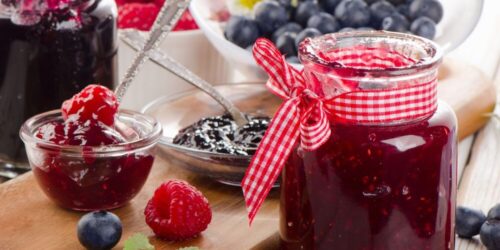








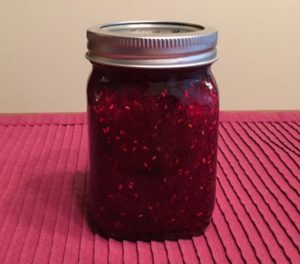
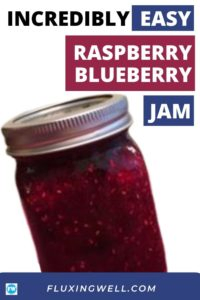


Yummie, I better try this! Never done anything similar but your instructions makes it look so easy:) Thank you!
You are most welcome! Enjoy making raspberry blueberry jam.
Perfect instructions on how to make easy canned raspberry blueberry jam. I love the combination of berries – both are delicious. Although I’ve never tried my hand at making jam – I’m inspired to give this recipe a go!
Great! Raspberry blueberry jam is a delicious flavor combination.
Mmm…this jam was delicious! I especially enjoyed it on warm scones. Thanks for the recipe.
I love it on scones too!
I’ve always been fascinated with the idea of canning for some reason, but I’ve never tried it lol! I might just have to give it a go this year to at least be able to say I tried…
Britt,
I know it might seem intimidating at first, but if you have the right tools, it’s pretty easy and satisfying. Do you know anyone who has a boiling water canner or a canning kit like I described? It might be good to borrow the equipment at first to see if you enjoy the process. That’s what I did when I was getting started. If you lived in Oregon, I’d let you borrow mine! I also helped someone else when she was canning peaches to see how it all worked. If you do try it, I’d love to know how it goes! Thanks for your comments!
Lisa
great post and now you making want to grow some berry for next year might include some eatable flowers if there is any on the island. Jam is a staple for me especially when I have to rush.
Sunshine,
Yes, I love to have jam on hand! Berries grow really well where I live, so I’m lucky. Including edible flowers seems like an interesting idea. Thanks for commenting, and I wish you success with growing berries!
Lisa
I’ve never thought of using zest in jam before! But of course it totally makes sense that it would be amazing! Thanks for sharing!
Kari,
The zest and pulp really add a lot of flavor. Thanks so much for your comment, and if you try the recipe, I’d love to know how it turns out.
Lisa
A must try. I love both fruits. My grandma use to preserve everything. Oooh that good smell when she was making apricot jam.
Andrea,
Yes, the smell is amazing, and it makes me feel good to have something homemade sitting on the pantry shelf. I hope you have the chance to give it a try. Thanks for your comment, and happy jam-making!
Lisa
I’ve never tried making jam but I love my dad’s home made jams! He grew loads of strawberries this summer so he made some tasty jars.
I love raspberry jam and blueberry jam but never tried them mixed together!
Maya,
Mixing the berries is something I’d never tried before this recipe either. But, why not? It’s a unique flavor, and I’m glad I just happen to have both kinds of berries on hand. Thanks for commenting, and have fun trying new jam experiments!
Lisa
Oh wow, this looks delicious! I have never made jam before but this I might have to try. Thank you for sharing!
-Kristen
Kristen,
I love making jam and having it on hand to share for gifts. If you do try your hand at jam-making, I’d love to know what you think. The canning kit really does make it a lot easier. Thanks for your kind comment, and good luck with any jam-making endeavors you try.
Lisa